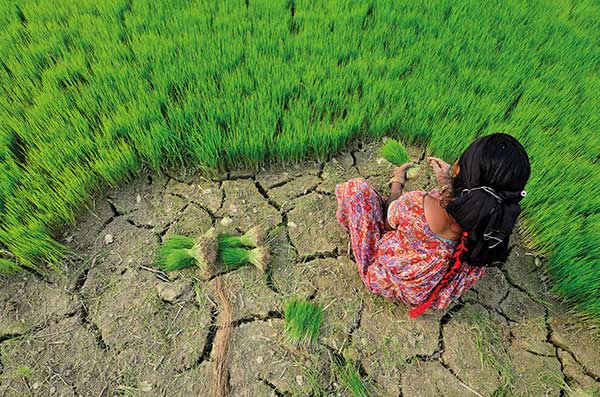Executive summary
The environment’s ability to support human life and wellbeing
ESPA’s scientists provide detailed scientific evidence to warn that, in certain regions, the natural environment has become so degraded that it fails to provide some of the critical functions needed for human survival and wellbeing. In some localities, such as Lake Erhai in China, this can be described as ecosystem collapse; in other locations – some covering hundreds of square kilometres such as tropical deltas – the ecosystems are entering ‘danger zones’ where active measures are needed to avert ecological collapse and safeguard human lives. One such delta is the Ganges–Brahmaputra–Meghna delta that is home to 40 million people.
The impacts of environment-related decisions on resource-dependent people
The overarching message of ESPA’s research is that policy and programmes that utilise environmental resources will inevitably carry implications for human wellbeing and may even bear hidden human costs – unless there is due assessment and care. These implications and any potential human costs must be adequately understood and explicitly addressed through open, just and democratic processes.
ESPA research has either explicitly or tacitly assumed that members of society must agree on the minimum social foundations necessary to create a ‘safe and just space’[ 1 ] for living within planetary boundaries.[ 2 ] , [ 3 ] This means: managing environmental resources in ways that avoid high risks of irreversible environmental changes, avoiding harm to vulnerable social groups living in poverty, and working to ensure that environment and development interventions raise vulnerable people out of poverty.
ESPA research shows that the architects of development policies and programmes that access and use environmental resources are largely failing to consider how these interventions will affect society’s most vulnerable and resource-dependent people. This is equally the case for policies and programmes that have environmental conservation as their primary goal, such as protected areas and carbon sequestration projects, as for ‘development first’ interventions.

The overarching message of ESPA’s research is that policy and programmes that utilise environmental resources will inevitably carry implications for human wellbeing and may even bear hidden human costs – unless there is due assessment and care. These implications and any potential human costs must be adequately understood and explicitly addressed through open, just and democratic processes.
Of particular importance, land-use intensification to increase yields of food and fibre has often had negative impacts on food security and incomes, particularly for the poor – and contrary to expectation. Land-use intensification is, in many cases, harming the broader set of ecosystem services that regulate the environment and maintain its health, and human wellbeing.
It is essential for decision-makers to identify – in specific localities – how services provided by the environment sustain local people’s lives and wellbeing, so that these benefits are not inadvertently harmed or destroyed. ESPA’s science urges decision-makers to consider the needs of society’s most vulnerable and marginalised people when it comes to the design and delivery of policies and programmes based on environmental resources.
The good news is that well-designed interventions can reward local people for actions that simultaneously (a) yield environmental benefits (that accrue locally, regionally and globally across scales) and (b) increase the flows of social, cultural and economic benefits to local people.
Fundamental to this finding is ESPA’s focus on ‘wellbeing’: the fact that local, resource-dependent people may value environmental resources differently from how external parties value them (see Box 1). There are ample decision-support and management tools and frameworks to assist decision-makers in identifying these considerations and negotiating better-informed choices. Many of these have been tested in new situations by ESPA researchers and are referenced in this summary.
By the same token, although some environment-related interventions can be shown to pose irreconcilable trade-offs, the tools and frameworks provide a basis for more robust decision-making. They do so by identifying those trade-offs explicitly – and so provide the basis for open discussion and the possibility to fairly compensate those who bear any costs.
Based on the larger body of evidence that inequity plays a role in keeping people in poverty – that is, their lack of voice in decisions over environmental resources and also lack of equity in how the benefits of those resources are distributed – ESPA has shone the spotlight on the need for equity and rights-based approaches. ESPA has developed decision-support tools and management frameworks to support effective participation in decision-making by those who rely on the environment.

Given the critical status of many environmental resources in many countries and subnational regions studied by ESPA, it is clear that the job of addressing these issues is challenging and complex and that the stakes are high. There is no room for complacency. There is a need to invest in monitoring ecological health and human wellbeing on an ongoing basis, and to learn from management successes and mistakes.
Recommendations for well-informed and fair decisions over environmental resources
- Decision-makers must identify the ‘hidden’ costs to the poorest in society, and the trade-offs in programmes and policies that access and use environmental resources, so that the most vulnerable people are not inadvertently left worse off. Environmental and social impact assessments for development interventions – and for environmental conservation programmes – are frequently inadequate. Assessments must capture local people’s dependencies on the natural environment. They must capture the possible impacts when local people’s access to and use of environmental resources are constrained. By making these costs explicit, projects and programmes may be rejected if they are deemed to cause harm to local people, or they may be completely redesigned in order to benefit poor people in the local area effectively.
- Methods for joint discovery and knowledge creation can help identify resource dependencies and trade-offs, especially in local and regional processes (although proxies may be found at global scales of decision-making). To develop sound understanding of the links between human and ecological systems requires a marriage of scientific knowledge with ground-truthed, more localised knowledge from the people who are affected by environmental decisions. Ideally, ‘consumers’ of the knowledge base on which decisions are made become active co-producers of this shared knowledge.
- Having identified the trade-offs, decision-makers must deliberately manage these interventions to avoid harm and to benefit the poorest. While all solutions need to be nationally and locally relevant, ESPA research nonetheless highlights a set of universally applicable core principles for sound environmental governance and management. Applying these principles can ensure that costs and trade-offs are identified and managed in a way that does no harm and helps the poorest.
- The core principles for designing and managing the use of environmental resources are as follows.
- Recognising and granting rights: Affected local people need statutory rights to access, manage and govern environmental resources – among these, officially recognised tenure rights are among the most important. Inequitable tenure rights among women and men remain one of the most persistent injustices, although inequitable rights among all social groups also need to be scrutinised and addressed.
- Accountability to affected people, across scales of governance: Policies and programmes should be designed with effective mechanisms in place to ensure that actors working across scales (local, national and global) of environmental extraction and use are accountable to affected local people.
- Transparency: The intended outcomes and beneficiaries of development and conservation interventions should be communicated transparently to all – and should be monitored and communicated on a regular basis.
- Participation: Socially marginalised groups should be empowered and actively supported to participate in environmental decision-making.
- Capacity development: It is not only the local people affected by the use of environmental resources who may need support in order to participate meaningfully in programme design and implementation. Programme managers themselves often need support and training to build the skills necessary to run effective, participatory and inclusive processes – and they need support to be ecologically and socially ‘literate’.
- Recognising and rewarding local stewardship: Local people’s stewardship of environmental resources and their contribution to flows of ecosystem services and goods – in their many forms – must be adequately recognised early in the decision-making process and sufficiently rewarded. Conditional transfers of cash and in-kind resources are one way of achieving this but may need to be augmented by other forms of recognition and reward.
- Adaptive processes and learning: As the physical sustainability of resource use is measured and monitored over time, so the social impacts must be measured and monitored. We live in a dynamic world of constant change: of local places that change continuously; of national, regional and global events and pressures that have local consequences. This means that the institutional and governance arrangements for use of and access to environmental resources must be under frequent review, including who benefits, and who may be harmed by the arrangements.
This policy summary explores – through short examples and references to the ESPA literature – exactly how these principles have been successfully put into practice and how decision-makers around the world can adopt them, to ensure that the use of environmental resources is right for the global environment and for locally affected people, including the poorest.



